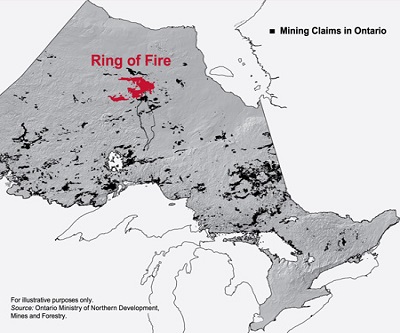
Despite the fact that a major stakeholder has iced the project, the Ontario government is making a major push for development of the massive Ring of Fire mineral deposit.
The provincial government announced on Friday that it had hired consulting firm Deloitte to help set a development corporation which would build infrastructure in the Ring of Fire region.
“Deloitte LLP will act as a neutral, third-party resource for key partners, including First Nations, the provincial and federal governments and industry,” the Ministry of Northern Development and Mines wrote in a news release.
“Work is also underway to help partners build a common understanding of infrastructure needs in the region. A third-party research report will examine existing infrastructure proposals and establish a common technical basis to inform decisions to maximize the economic and social potential of the Ring of Fire region.”
Last year the Ontario government announced the creation of a development corporation for the Ring of Fire which brought together mining companies, government bodies and First Nations communities.
Negotiations between these parties have stalled development for some time now: The provincial and federal governments can’t agree on who should pick up the tab and they have yet to reach an agreement with the Matawa First Nations Council.
“We remain committed to making a significant investment to support infrastructure needs in the region, but we need partners to come together so that decisions can be made,” Michael Gravelle, minister of Northern development and mines said in a statement on Friday.
A lack of infrastructure – particularly an all-weather road – has been a major sticking point. Last November Cliffs Natural Resources suspended its $3.3 billion Ring of Fire chromite mine due to an “uncertain timeline and risks associated with the development of necessary infrastructure,” Cliffs Vice-President Bill Boor said at the time.
Following the release of its 2014 budget, the Federal government was criticized for not including the Ring of Fire.
“The Harper government was willing to invest in Alberta’s oil sands and large energy projects in Newfoundland and Labrador, but won’t partner with Ontario to develop the huge Ring of Fire mineral deposit or meet its infrastructure needs,” Ontario Premier Kathleen Wynne said, as reported by the Canadian Press.
The Ring of Fire deposit – located in northwestern Ontario – is considered so economically promising that it’s been dubbed ‘Ontario’s oilsands.’ Its worth in chromite, nickel and gold is estimated at $60 billion. Key companies with claims in the region include Cliffs, KWG Resources and Noront Resources, but there are dozens more.
Comments
Fred Brown
Wynne’s Ontario liberal government can not disclosed the Deloitte Report nor the joint federal and provincial funded east west Ring of Fire $785,000 transportation corridor study until Ontario controls the only economically viable way to get the chromite to market.
Back in June of 2012, Ontario mining minister Rick Bartolucci had said Cliffs Natural Resources would “take the lead on figuring how the road to the Ring of Fire was to be built and financed”. However, Linda M. Kamerman, the Ontario Mining and Lands Commissioner, sided against Cliffs and the Ontario government’s easement of the north-south chromite corridor.
Ontario was actually offering to publicly subsidize corporate power rates for Cliffs’ proposed mine and concentrator, the Capreol smelter, full provincial public funding of the $600M north-south mine ore transportation all-weather private corporate toll trucking road, and ministerial exemptions to ship 50% of the chromium concentrate out of province, while closing down the competing ONTC, who had a rail proposal for the area.
The provincial government was then forced to intervene in the case of 2274659 Ontario Inc. and MNR v. Canada Chrome Corporation easement appeal case through the Office of the Attorney General of Ontario. Like magic, Ontario’s divisional appeal court judge Swinton came to the opposite decision!
The appeal of the appeal is now before the Divisional Appeals Court of Ontario and commences in late November 2015.
Once Ontario has removed Canada Chrome Corporation from the Ring of Fire, then it’s development corporation can release the Deloitte Report and award Noront Resources full control over the coveted ore transport toll route and give the Matawa First Nations a better revenue sharing deal.
The federal Liberal party of Canada was wise to avoid involvement in Ontario’s Ring of Fire. Thunder Bay Superior North Liberal MP Patty Hajdu said her party will offer up to $10 billion dollars a year for two years for infrastructure — and let provinces and municipalities decide how to spend it. She noted it’s not up to the federal government to dictate priorities for other levels of government.
Wynne’s Ontario liberal government could not produce a ROF plan for federal Conservatives without full control over the chromite route.